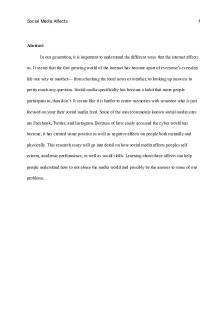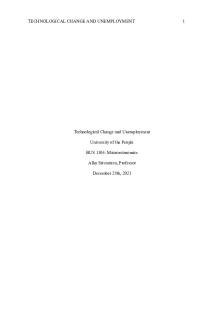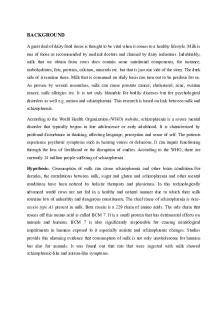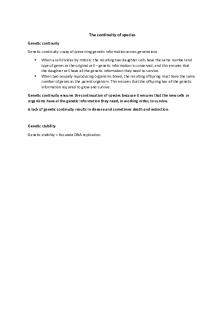A Qualitative Study: Social Networking Sites and its Effects on Anxiety, Depression, and Well-being PDF

| Title | A Qualitative Study: Social Networking Sites and its Effects on Anxiety, Depression, and Well-being |
|---|---|
| Author | Cem Baştüzel |
| Pages | 45 |
| File Size | 190.4 KB |
| File Type | |
| Total Downloads | 296 |
| Total Views | 690 |
Summary
SNS AND ITS EFFECTS ON ANXIETY, DEPRESSION AND WELL-BEING 1 Social Networking Sites and its Effects on Anxiety, Depression, and Well-being Cem Baştüzel and Rayaan Amir Department of Psychology, Istanbul Bilgi University Oya MASARACI SNS AND ITS EFFECTS ON ANXIETY, DEPRESSION AND WELL-BEING 2 Content...
Description
SNS AND ITS EFFECTS ON ANXIETY, DEPRESSION AND WELL-BEING
Social Networking Sites and its Effects on Anxiety, Depression, and Well-being Cem Baştüzel and Rayaan Amir Department of Psychology, Istanbul Bilgi University
Oya MASARACI
1
SNS AND ITS EFFECTS ON ANXIETY, DEPRESSION AND WELL-BEING
2
Contents Abstract………………………………………………………………………………………….... 3 Introduction………………………………………………………………………………………..4 Depression……………………………………………………………………………………..5 Anxiety………………………………………………………………………………………...6 Well-being……………………………………………………………………………………..7 Literature Review………………………………………………………………………………….8 Method…………………………………………………………………………………………... 15 Participants…………………………………………………………………………………...15 Materials…………………………………………………………………………………….. 15 Design……………………………………………………………………………………….. 16 Procedure……………………………………………………………………………………. 16 Data Analysis………………………………………………………………………………... 18 Results…………………………………………………………………………………………....18 Usage, activities and likes and dislikes of SNS’s…………………………………………… 19 Expression of feelings and oneself ………………………………………………………….. 23 SNS can lead to negative thoughts, anxiety and a low sense of well-being………………… 25 Accessibility, moderation of and general opinions about SNS……………………………....30 Discussion……………………………………………………………………………………….. 32 Limitations…………………………………………………………………………………... 34 Recommendations…………………………………………………………………………....35 Trustworthiness……………………………………………………………………………....35 References………………………………………………………………………………………..36 Appendix A…………………………………………………………………………………........42 Appendix B…………………………………………………………………………………….... 43 Appendix C…………………………………………………………………………………….... 44
SNS AND ITS EFFECTS ON ANXIETY, DEPRESSION AND WELL-BEING
3
Abstract There seems to be a conflict in interests in regards to whether Social Networking Sites (SNS) are more beneficial or problematic amongst adolescents. Our aim is to gain further insight into this matter by collecting data from eight students currently studying at Istanbul Bilgi University. Almost all the previous research in this area deals with quantitative rather than qualitative data. Due to the limited amount of information readers have, there remains to be a good deal of confusion with such a topic. Thereby, we chose to gather data that is qualitative in nature. Participants were selected by convenience sampling and their feedback was taken with the help of an interview. Data analysis included identifying words/phrases most commonly used, and creating themes and sub-themes from it. Data from other qualitative studies regarding this topic were also compared to our findings to observe any major differences in the subjectivity of participants’ responses. Research is limited and a conclusion has not been reached as some researchers favor SNSs (for example Deters, Mehl, and Eid, 2014) while others argue (such as Staksrud, Ólafsson, & Livingstone, 2013). Our results showed that overall, SNSs in general lead to more negative thoughts, anxiety, and lower sense of well-being, and we observed what possible factors cause such feelings. Keywords: SNS, Social Media, Depression, Anxiety, Well-being
SNS AND ITS EFFECTS ON ANXIETY, DEPRESSION AND WELL-BEING
4
Social Networking Sites and its Effects on Anxiety, Depression, and Well-being Early adulthood is a very important period in a person’s life. It is a period where the person undergoes psychological as well as physical changes in his/her body as they adjust to their emergent needs and develop new skills, responsibilities, and intimate relationships (Christie & Viner, 2005; Erikson, 1968). As stated by Erikson: ‘’It is during adolescence where children develop a sense of identity and true autonomy.’’ Particularly early and middle adolescence is marked by increased self-centeredness. Adolescents frequently participate in what has been referred to as "imaginative conduct of the audience": they tend to overestimate the degree to which others are observing and assessing and, as a result, they may be extremely concerned about how they look in others' hands. Interpersonal feedback is often open to all other members of the site on social networking sites. These community perceptions are especially likely to affect the personal self-esteem of adolescents. This is a dynamic period of life and one that is potentially more difficult in contemporary environments as adolescents deal with different personal and academic stresses, different from those faced by previous generations. This time is often made more difficult because of the high prevalence of mental health problems (Burns, Durkin, & Nicholas, 2009), as many mental disorders are first diagnosed during puberty (Patel, Flisher, Hetrick, & McGorry, 2007). When talking about the ideas mentioned so far, three words in particular jump to mind; “Depression,” “Anxiety” and “Well-being.” These three terms tend to be highly associated with our subject matter. Before we go into how they are associated, let's begin by outlining the basic understanding of these keywords.
SNS AND ITS EFFECTS ON ANXIETY, DEPRESSION AND WELL-BEING
5
Depression Depression is often confused with the term “sadness,” however with the help of previous research, it is clear the depression is categorized as a medical illness under which sadness is considered as one of the symptoms. Other symptoms may involve neglect, guilt, fatigue, etc. (Singh & Mastana, 2015). The term is also confused with other words such as anxiety, however, the next subsection will explain the difference. Depression usually comes about with particular life events from which symptoms begin to emerge. According to Singh and Mastana (2015), such life events could be childhood neglect, problems at work, encountering the death of loved ones, and so on. It may also arise with individuals suffering from other illnesses such as cancer or chronic pain. Often, it is usually the treatment of these illnesses that stress the individual and result in depression. The debate on whether depression is more inclined towards nature or nurture still remains, however, the authors suggest that it can be either, or a combination of the two; biological and genetic as well as stressful situations that together trigger us to enter a stage of depression. Beck and Alford (2009) believe that most of these problems are biological but still take nurture into account. They suggest various sorts of treatments individuals use to overcome depression, including Monoamine oxidase inhibitors (MAOIs), Electroconvulsive therapy, and Psychotherapy, however, these treatments come with further possible problems. For example, side effects are likely to arise from medication, Electroconvulsive therapy may have psychological effects such as impairment of memory, and Psychotherapy may not always be effective. Depression has many possible causes including faulty mood regulation by the brain, genetic susceptibility, stressful life events, medications, and medical problems. Several of these
SNS AND ITS EFFECTS ON ANXIETY, DEPRESSION AND WELL-BEING
6
factors collaborate in the causation of depression. A study involving only qualitative data such as ours will not be able to quantify depression, but we can get insight into whether participants were clinically diagnosed as depressed or whether they felt depressed. Anxiety Horwitz’s (2013) book covers the concept of the term “anxiety” and the author affirms that anxiety is a more general word rather than being explicitly connected to something. Based on research, Horwitz believes that anxiety often comes about when an individual is tackled with an object or situation which he/she must respond to, and thus the emerging fear is what grounds anxiety. Furthermore, culture can play an immense role in judging and differentiating between who is anxious and normal, as opposed to who is anxious and disordered. As time progresses, the concept of anxiety is becoming widely popular amongst drug companies, clinicians, policymakers, etc. Bourne and Garano (2016) advise techniques individuals may use to help cope with their anxiety. These include relaxing the body and mind, thinking realistically, facing one’s fears, regular exercise, eating healthy, staying calm, nourishing yourself, making life simpler, and coping on the spot. Well-being During the 1970s, researchers viewed health and well-being as equal to the absence of physical disease or mental disorder. Today, authors and researchers are attempting to define well-being in a more precise way. The book entitled “Well-being: positive development across the life course” underlines that well-being involves areas of cognitive and behavioral functioning, along with physical and mental health (Bornstein & Bornstein, 2013). An ambition lies to create a definition that covers these aspects, for both children and adults. Currently,
SNS AND ITS EFFECTS ON ANXIETY, DEPRESSION AND WELL-BEING
7
well-being amongst children is said to be present and correlates with factors when the child exhibits positive behaviors relating to success in academics, athletics, arts, etc. and problem behaviors are removed. Bornstein and Bornstein further claim that life events only create stress when perceived in a particular way, and the way individuals try to cope with those events (including the amount of social support they have) can be a result of their well-being. Personality traits play a big role here, for example, a study claims to confirm that some personality traits moderate the association between Facebook social comparison and subjective well-being (Gerson, Plagnol, & Corr, 2016). Recently, “positive psychology” is gaining more recognition towards assisting individuals to reach a point of well-being. Literature Review Social networking sites (SNS) have been an important part of our lives for a prolonged time. Boyd and Ellison (2007) define SNS as a “web-based services that allow individuals to (1) construct a public or semi-public profile within a bounded system, (2) articulate a list of other users with whom they share a connection, and (3) view and traverse their list of connections and those made by others within the system.” The term, however, is still a relatively new concept in the lives of adolescents. An SNS is a digital platform for establishing relationships with others who share an interest, history, or real relationship. Members of social networking sites create a profile that includes personal data, images, etc. and link to other accounts. Then these people use their contact to build relationships by posting, emailing, instant messaging and blogging (Kenton, 2019). Many SNS members do not necessarily develop a network to meet new people but rather to communicate with people who are already a part of their existing social networks (Ellison et al., 2007). It is also possible to refer to social networking sites as a "social networking
SNS AND ITS EFFECTS ON ANXIETY, DEPRESSION AND WELL-BEING
8
site" or simply "social media."It is estimated that 97% of teenagers in the United States use the internet (Ybarra, 2004). Young adults on average have different reasons to access SNS’s. According to statistical research, the most important reason is to get in contact with new individuals (approximately 31%), the second being to keep in touch with friends (approximately 21%), whilst the third involving everyday general socializing (approximately 14%) (Boyd and Ellison, 2007). With the increased usage of the internet, research has begun to investigate the psychological and social impacts of living with the internet. As the years progress, the usage of social media increases in correlation, and the popularity of SNS networks change accordingly. In 2010, research revealed Facebook and Live Spaces to be most preferred by participants (Bicen & Cavus, 2010). When you look around your environment nowadays, it is clear that SNS’s such as Instagram are gaining more attention than ever. The age for first-time exposure to SNS is also declining. It is plausible to say that the average age to start internet activity is even younger now that we have entered the year of 2020. Usage of SNS comes with its risks as well. Research about the benefits or side effects of SNS’s has been rather ambiguous. Although SNS’s have become tremendously popular among adolescents and young adults, there is little research that focuses specifically on the uses and implications of such sites. This is remarkable because networking sites are exceptionally well suited to investigating the social implications of internet communication. After all, peer recognition and implicit self input are critical predictors of social self-esteem and well-being in adolescence and young adulthood, both essential features of SNS’s. Adolescents become more exposed to various types of harassment like verbal and sexual harassment, hate comments, bullying and etc. As a result, this may lead to a compromise in the
SNS AND ITS EFFECTS ON ANXIETY, DEPRESSION AND WELL-BEING
9
adolescent’s mental health and well-being. Based on previous research, we discover that SNS can have several negative effects on adolescents. A study conducted by Ybarra (2004) has found out that every one in 20 young internet users has reported being the target of some form of internet harassment in the previous year. Harassment in comparison to bullying was much more frequent. It has also been found that those who report being harassed online also possess depressive symptoms in comparison to non-targets. 30% of these young people also reported feeling very extremely sad about the incident. It could be concluded that online harassment is a significant mental health issue. Further literature review involves a study analyzing how the effects of social media in the sense of mental well-being are seen by the adolescents themselves (O’Reilly, Dogra, Whiteman, Hughes, Eruyar & Reilly, 2018). Findings point out that adolescents are aware that social media is something that shouldn't be taken lightly. They presumed social media to be the root of depression, suicidal ideation, and addiction. Additionally, they have blamed social media for causing negative effects on their age group. Recommendations put forward state that social media should be utilized in such a way that it promotes mental well-being and warns young people about the potential dangers of it. Another risk factor posed by SNS’s is how easy it is to build and maintain relationships online. At first glance, this may present itself as something good, however that may not always be the case. Over the past few years, users' opportunities to form and maintain relationships on the Internet have multiplied. Social networking sites have gained prominence as platforms for the creation of relationships. Valkenburg (2006) focused on relationship building sites and their consequences of adolescents’ self-esteem and mental well-being. This has been one of a kind study signifying the effects of friend networking sites on
SNS AND ITS EFFECTS ON ANXIETY, DEPRESSION AND WELL-BEING
10
self-esteem and well being. Results reveal that the self-esteem of adolescents is directly affected by the comments and the feedback they received upon their profiles. When faced with positive feedback it facilitated adolescents' self-esteem and negative feedback decreased it. SNS use affects self-esteem by providing multiple opportunities for selective self-presentation through photos and personal details. Tazghini and Siedlecki (2013) found a negative association between self-esteem and Facebook activity. This association was related to actions like untagging undesirable pictures or adding others as friends who they are not familiar with. Similarly, a survey indicated that Facebook has an adverse impact on self-esteem and body image. Spent time on social network sites endorsed more positive self-views (Center for Eating Disorders at Sheppard Pratt., 2018). A study conducted by Staksrud, Ólafsson, & Livingstone (2013) yields that SNS certainly increases the number of risks children may stumble upon. Greater digital skills do not lessen the chance of online risk but increase children's motivations to explore the internet even further. Children who had private SNS profiles have greater security over those who do not. The data further uncovers that digital competence does not reduce the chance of children stating that they have been upset by something on the internet but it lies with the child and their circumstances rather than the use of their SNS. As we can see based on previous experimentation, a handful of studies show evidence of the dark side of SNS, something which the average adolescent may underestimate or misjudge. However, one must take into account that the way SNS is viewed as something “bad” may be exaggerated in some cases. Setting aside all the negativity and disapproval about SNS, many of us often fail to realize the value social networking sites provide to those facing tough situations. Shaw and Gant (2002) found that participants chatting anonymously on the internet felt less lonely and
SNS AND ITS EFFECTS ON ANXIETY, DEPRESSION AND WELL-BEING
11
depressed, while social support and self-esteem rose. Networking sites such as Twitter have also shown to be a useful tool in aiding individuals with depression. A study conducted in 2016 showed that many tweets posted by individuals using the site were supportive or helpful tweets in regards to depression. Findings like these help remove the average stereotypical way of thinking, thereby allowing us to acknowledge that certain networking sites may not be as harmful as once previously thought (Cavazos-Rehg, Krauss, Sowles, Connolly, Rosas, Bharadwaj, & Bierut, 2016). Other studies show results that further capture our interest. For example, Facebook, an SNS that is often viewed as quite problematic in regards to our topic demonstrates its positive side. A study however reveals that participants who had previously experienced several life stressors, joining and interacting on Facebook helped turn such problems around. In particular, the number of friends a participant had on their account showed to be a powerful predictor of perceived social support. The data further reveals that such a perception of social support helped increase the participant’s wellbeing. In addition, for those who have experienced many objective life stressors, the number of Facebook friends emerged as the stronger predictor of perceived social support (Nabi, Prestin, & So 2013). More research on Facebook shows that the experimentally induced increase in status updating activity can reduce loneliness (Deters, Mehl and Eid, 2014). Psychologists reason that such a decrease in loneliness is usually because of participants feeling more connected to their friends on a regular daily basis. Also, the effect of posting on loneliness was completely independent of direct social feedback (such as responses) by friends. As we know, decreasing loneliness can as a result drop levels of depression and anxiety, thus making such studies crucial to further guide us in this area. It is essential for the reader to know that an SNS like Facebook is also used for educational purposes
SNS AND ITS EFFECTS ON ANXIETY, DEPRESSION AND WELL-BEING
12
including the communication of school-related news (Bosch, 2009 as cited in Idrus & Hitam, 2014; Roblyer et al., 2010 as cited in Idrus & Hitam, 2014). Nevertheless, when looking at the statistics as a whole, it is evident that Facebook’s general use is grounded in social purposes (Pempek et al., 2009). Further research on this matter indicates that both Instagram interaction and browsing displayed lower levels of loneliness, whereas Instagram broadcasting was associated with higher loneliness and better psychological well-being (Yang 2016). Therefore, results revealed the benefits of healthy SNS use and how different personality traits may affect the data. Researchers have also explored students attitudes towards such areas and learne...
Similar Free PDFs

Social Media and Effects on Behavior
- 10 Pages

Oc spray and its effects
- 3 Pages

Health and Wellbeing
- 27 Pages

Overview on Cloud and Networking
- 33 Pages
Popular Institutions
- Tinajero National High School - Annex
- Politeknik Caltex Riau
- Yokohama City University
- SGT University
- University of Al-Qadisiyah
- Divine Word College of Vigan
- Techniek College Rotterdam
- Universidade de Santiago
- Universiti Teknologi MARA Cawangan Johor Kampus Pasir Gudang
- Poltekkes Kemenkes Yogyakarta
- Baguio City National High School
- Colegio san marcos
- preparatoria uno
- Centro de Bachillerato Tecnológico Industrial y de Servicios No. 107
- Dalian Maritime University
- Quang Trung Secondary School
- Colegio Tecnológico en Informática
- Corporación Regional de Educación Superior
- Grupo CEDVA
- Dar Al Uloom University
- Centro de Estudios Preuniversitarios de la Universidad Nacional de Ingeniería
- 上智大学
- Aakash International School, Nuna Majara
- San Felipe Neri Catholic School
- Kang Chiao International School - New Taipei City
- Misamis Occidental National High School
- Institución Educativa Escuela Normal Juan Ladrilleros
- Kolehiyo ng Pantukan
- Batanes State College
- Instituto Continental
- Sekolah Menengah Kejuruan Kesehatan Kaltara (Tarakan)
- Colegio de La Inmaculada Concepcion - Cebu











